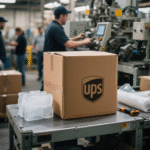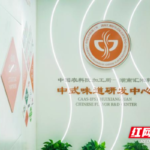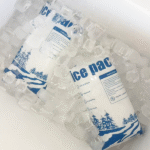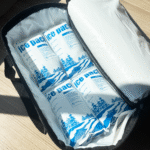Pouvez-vous utiliser de la glace sèche dans une glacière pour des voyages plus longs?
L'utilisation de la glace sèche dans une glacière est le moyen le plus rapide de garder les aliments congelés pendant des jours, Si vous suivez quelques règles de sécurité. Dans ce guide, you’ll learn exactly comment use dry ice in a cooler, combien emballer, Et ce que le 2025 Les limites des compagnies aériennes signifient pour vous.

-
How much dry ice you actually need for popular cooler sizes
-
Which cooler materials handle dry ice best and why
-
Step‑by‑step packing that maximizes cooling time and minimizes risk
-
Travel regulations for 2025 and what they mean for your next flight
-
Pro tips to stay safe and get the best value from every pound
How Much Dry Ice Do You Need for a Cooler?
Planifiez sur 10 lb (4.5 kg) per day for a 50‑qt cooler—adjust up or down based on size and outside temperature. Ne pas plus de 5,5 lb (2.5 kg) Si vous volez; C'est la limite de la FAA.
Glace sèche sublimate (passe du solide au gaz) faster when there’s empty air space, so fill gaps with newspaper or towels to stretch cooling time. For weekend camping in summer, a well‑packed 60‑qt cooler with 20 lb of dry ice can keep meat rock‑solid for 48 hours.
Dry Ice Weight vs Cooler Size Chart
| Taille plus froide | Sécher (lb / kg) | Hours Below 32 °F | Ce que cela signifie pour vous |
|---|---|---|---|
| 20 QT (19 L) | 5 / 2.3 | ~ 24h | Perfect for day trips—fits TSA air‑travel limit |
| 50 QT (47 L) | 10 / 4.5 | ~ 48h | Ideal for two‑day camping or road travel |
| 80 QT (76 L) | 15 / 6.8 | ~ 72h | Great for long weekends—requires robust cooler |
Conseils pratiques
-
Pré-Chill tout: A frozen cooler needs less dry ice.
-
Coucher intelligent: Dry ice on top freezes items underneath faster.
-
Vent gently: Crack the drain plug so CO₂ can escape, Empêcher l'accumulation de pression.
Cas réel: A 55‑qt roto‑molded cooler packed with 12 lb of dry ice and 20 lb of frozen meals stayed below 20 °F for 60 hours on a June RV trip.
What Type of Cooler Works Best with Dry Ice?
Roto‑molded hard coolers or thick‑walled styrofoam boxes handle dry ice best because they insulate well and tolerate extreme cold. Avoid air‑tight latches; CO₂ gas must vent safely. Thin picnic coolers can crack at –109 °F (–78 ° C), the temperature of dry ice.
Key Cooler Features
-
Gasket that seals but still allows slight venting
-
Drain plug you can loosen for gas release
-
Minimum 2‑in (5 cm) wall insulation
-
UV‑resistant shell for sunny campsites
| Fonctionnalité | Pourquoi ça compte | Bénéficier à vous |
|---|---|---|
| Thick walls | Reduces sublimation rate | Less ice needed, lower cost |
| Vent‑ready drain | Prevents pressure buildup | Safer transport |
| Rugged hinges | Withstands –109 °F swings | Longer cooler lifespan |
How to Pack a Cooler with Dry Ice Step by Step
-
Pre‑freeze food & boisson to at least 0 °F.
-
Portez des gants isolés; dry ice burns skin instantly.
-
Place cardboard at the bottom to protect the liner.
-
Add a dry‑ice slab, then a newspaper layer.
-
Load items tightly, biggest to smallest.
-
Top with another dry‑ice slab for even cooling.
-
Loosen the drain plug or crack the lid ¼ inch during transport.
Interactive idea: Try our 30‑second Dry Ice Calculator to size your load (embed or link).
Is It Safe to Travel with Dry Ice in Your Cooler?
Yes—if you keep it vented, étiqueté, and under 5.5 lb (2.5 kg) for air travel. Always inform the airline at check‑in and mark the cooler “Dry Ice (2.5 kg or less).” TSA officers have final say at security, so arrive early.
Road‑tripping? Crack a window; CO₂ is heavier than air and can pool in car footwells. À la maison, store the cooler in a shaded, well‑ventilated space—never in a sealed basement.
2025 Dry Ice Cooler Innovations and Regulations
Carbon‑composite vented lids launched this year cut sublimation by 15 %, and several airlines now let you pre‑pay online for dry‑ice approval, speeding up airport queues (Delta and Alaska piloted programs in April 2025). Entre-temps, portable CO₂ monitors under $30 make real‑time safety easier for campers.
Dernières points forts
-
Smart lids: Built‑in CO₂ vents that self‑adjust to internal pressure
-
Lightweight slabs: Aerogel‑backed dry‑ice sheets extend cold 20 % longer
-
Eco sourcing: NOUS. ethanol plants reclaim waste CO₂, lowering footprint
Perspicacité du marché: Demand for dry‑ice shipping kits jumped 18 % in 2024—home meal kits and biologic meds are key drivers.
Questions fréquemment posées {#FAQ}
Q1: Combien de temps dure la glace sèche dans une glacière?
Typically 18–24 hours per 5 lb block, depending on insulation and outside heat.
Q2: Can I combine dry ice with regular ice?
Yes—place regular ice above the dry ice to keep it frozen longer.
Q3: How do I dispose of leftover dry ice?
Let it sublimate outdoors on a tray, well away from kids and pets.
Q4: La glace sèche endommagera-t-elle ma glacière?
Not if you add a cardboard layer; direct contact can crack thin plastic.
Résumé & Plats à emporter
Using dry ice in a cooler is the fastest route to multi‑day freezing. Remember the 5.5 lb flight limit, choose a thick‑walled vent‑ready cooler, layer dry ice and food correctly, and always allow CO₂ to escape. Follow these steps and your food stays colder, longer—with zero safety surprises.
Que faire ensuite
-
Size your cooler load with our Dry Ice Calculator.
-
Grab vent‑friendly accessories from Tempk’s cooler line.
-
Partagez ce guide with your travel buddies for a safer trip.
À propos
We design high‑performance insulated coolers and ice packs that keep perishables at target temperature for up to 72 hours. Notre R&D center in Shanghai tests every product to ISTA standards, giving you reliability you can count on—whether you’re camping, restauration, or shipping vaccines.
Ready to chill smarter? Contact our experts for personalized advice.























